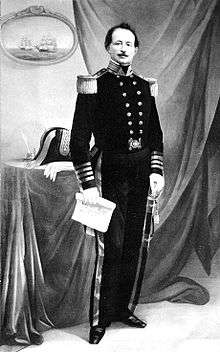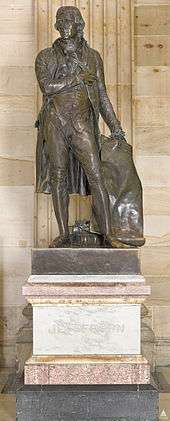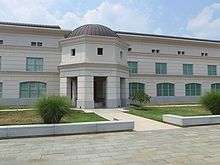Uriah P. Levy
| Uriah P. Levy | |
|---|---|
 | |
| Birth name | Uriah Phillips Levy |
| Born |
April 22, 1792 Philadelphia, Pennsylvania |
| Died |
March 26, 1862 (aged 69) New York City |
| Place of burial | Beth Olom Cemetery, Queens, New York |
| Allegiance |
|
| Service/branch |
|
| Years of service | 1806 - 1860 |
| Rank | Commodore |
| Commands held |
USS Vandalia USS Macedonian USS Franklin Mediterranean Fleet |
| Battles/wars |
Barbary Wars War of 1812 |
Uriah Phillips Levy (April 22, 1792 – March 26, 1862) was a naval officer, real estate investor, and philanthropist. He was a veteran of the War of 1812 and the first Jewish Commodore of the United States Navy.[note 1] He was instrumental in helping to end the Navy's practice of flogging, and during his half-century-long service prevailed against the antisemitism he faced among some of his fellow naval officers.
An admirer of Thomas Jefferson, Levy purchased and began the restoration of Monticello in the 1830s; he also commissioned and donated a statue of Jefferson that is now located in the Capitol Rotunda; it is the only privately commissioned artwork in the Capitol.
Early years
Levy was born on April 22, 1792, in Philadelphia, Pennsylvania to Michael and Rachel Phillips Levy.[1] He had two older siblings. Uriah Levy was close to his maternal grandfather, Jonas Phillips, who had emigrated to the United States in 1756 from Germany, and fought with the Philadelphia militia in the American Revolution. His maternal great-great grandfather, Dr. Samuel Ribeiro Nunes, a Portuguese physician, was among a group of 42 Sephardic Jews who escaped the Spanish Inquisition of the early 16th century and migrated to England, where they settled. Descendants of that group sailed from London in 1733 and helped found the city of Savannah, Georgia, where they lived for generations.[2]
Levy's younger brother was Jonas Phillips Levy, who became a merchant and sea captain. He was the father of five, including the Congressman Jefferson Monroe Levy.
Family stories have it that Levy ran away from home at the age of ten and ended up serving on various vessels as a cabin boy, returning home to Philadelphia at age 13 for his bar mitzvah.
Career
In 1806, he apprenticed as a sailor and was a cabin boy. Later he became a sailing master in the U.S. Navy,[3] and fought in the Barbary Wars.
At the age of 21, he volunteered for the War of 1812 and was commissioned as a sailing master on October 21, 1812. He was a supernumerary sailing master on the Argus, which interdicted British ships in the English Channel. The Argus seized more than 20 vessels before being captured on August 14, 1813; her captain was killed, and the crew, including Levy, were taken prisoner.[4] They were imprisoned by Great Britain for sixteen months until the end of the war. During his captivity, Levy had difficulty obtaining a subsidy and parole because his status as a supernumerary was not understood by the British Transport Board.[5]
Upon return to the United States, Levy served aboard the Franklin as second master. Levy was promoted to the rank of lieutenant in 1817. This commission was a rare feat, given that he started as a cabin boy and worked his way to being a sailing master.[3] He became a master commandant in 1837, and captain in 1844.
During his service in the U.S. Navy, Levy faced considerable antisemitism.[3] He reacted to slights and was court-martialed six times, and once demoted from the rank of Captain.[3] Twice, he was dismissed from the Navy, but reinstated. He defended his conduct in his handling of naval affairs before a Court of Inquiry and in 1855 was restored to his former position.
Later, Levy commanded the Mediterranean Squadron. As a squadron commander he was given the title of commodore, then the highest position in the U.S. Navy.
Levy was instrumental in abolishing flogging in the U.S. Navy, although his position was considered controversial at the time. He also helped gain the support of the U.S Congress in passing an anti-flogging bill in 1850.[6]
Levy became wealthy by investing in New York City's real estate market.[7]
Philanthropic activities
Levy undertook various philanthropic endeavors, many of which were in support of Jewish-American life. In 1854 he sponsored the new Jewish seminary of the Bnai Jeshurun Educational Institute in New York.
In 1833, New York City gave Levy the Key to the City after he presented the city with a patinated plaster statue of Thomas Jefferson, the one used to cast the bronze version he gave to the U.S. Congress.[8] Before the statue was set up in New York City Hall, Levy installed it in a building on Broadway and charged admission to view it. The proceeds were used to buy bread for the city's poor.[8]
Monticello
Levy was a great admirer of Thomas Jefferson:[9]
"I consider Thomas Jefferson to be one of the greatest men in history, the author of the Declaration and an absolute democrat. He serves as an inspiration to millions of Americans. He did much to mould our Republic in a form in which a man's religion does not make him ineligible for political or governmental life."
The Monticello estate had been owned by more than one person since Jefferson's death, and considerable property had been sold off. In 1834, Levy paid $2,700 for the 218-acre (88 ha) Monticello—which is equivalent to $64,100 in today's dollars. Levy undertook to have the long-neglected home repaired, restored, and preserved. He also bought hundreds of additional acres that had been part of the plantation, to add to what was left.
Levy used Monticello as a vacation home. From 1837 to 1839, his widowed mother Rachel Levy lived there until her death; she is buried along Mulberry Row, the main plantation street adjacent to the mansion.[10]
Upon his death in 1862, Levy left Monticello to the American people to be used as an agricultural school for the orphans of Navy warrant officers. Because of the American Civil War, Congress refused to accept the donation. The Confederate government seized and sold the property; lawyers for Levy's estate recovered the property after the war.
Following two lawsuits by family members over Levy's will, with 47 parties to the suit, in 1879 his nephew Jefferson Monroe Levy bought out the other heirs for $10,050, and took control of Monticello.[11] He had it repaired and restored. He sold it in 1923 to the Thomas Jefferson Memorial Foundation, which has renovated and restored the property as a house museum.

The Levy family's role in preserving Monticello was downplayed by the Thomas Jefferson Foundation through much of the 20th century, which Urofsky suggests was due to anti-Semitic views among some of its board and members.[12]
In 1985, the Thomas Jefferson Foundation restored the gravesite of Rachel Levy and honored descendants of the family in a ceremony at Monticello.[13] The Foundation also celebrates the roles of Uriah P. Levy and Jefferson Monroe Levy in helping preserve and restore Monticello, including on-site information about their roles.
Jefferson statue
In another tribute to Jefferson, Levy commissioned a bronze statue of the President while studying naval tactics in France; he donated it to Congress in 1834. The statue, which currently stands in the Capitol Rotunda is the only privately commissioned piece of artwork in the Capitol.[9]
Personal life
Levy served as the first president of the Washington Hebrew Congregation in Washington, DC.[6]
At the age of 61, Levy married his 18-year-old niece Virginia Lopez.[9]
Levy died on March 26, 1862, and was buried in Beth Olom Cemetery, Queens,[1] associated with the Spanish and Portuguese Synagogue.[9] He was one of the ranking officers of the Navy at the time of his death.[14]
Dates of Rank
- Sailing Master - 21 October 1812
- Lieutenant - 5 March 1817
- Master Commandant - 9 February 1837
- Captain - 29 March 1844
Legacy and honors


- Commodore Levy Chapel, the Jewish Chapel at Naval Station Norfolk, Norfolk, Virginia, and the Commodore Uriah P. Levy Center and Jewish Chapel at the United States Naval Academy in Annapolis, Maryland are named in his honor.
- 1988, listed in the Jewish-American Hall of Fame[15]
- 1959, the Jewish Chapel at Naval Station Norfolk in Norfolk, Virginia was renamed the "Commodore Levy Chapel" in Levy's honor.
- 2001, the Thomas Jefferson Foundation published The Levy Family and Monticello 1834-1923, a history of the Levy family's nearly century-long contributions in saving Monticello.
- 2005, the Commodore Uriah P. Levy Center and Jewish Chapel opened at the United States Naval Academy in Annapolis, Maryland, which is named in his honor.
- The Cannon class destroyer escort, the Levy (DE-162) was named in his honor. At the conclusion of World War II, the Levy hosted the U.S. representative for the surrender of Wake Island.[16]
- 2011 A statue of Uriah P. Levy by the Russian sculptor Gregory Pototsky was dedicated on December 16, 2011, outside Mikveh Israel Synagogue on Independence Mall in Philadelphia. The statue pedestal was designed by John Giungo.[17]
Published works
- Levy, Uriah Phillips; Butler, Benjamin F. (1858). Defence of Uriah P. Levy: Before the court of inquiry held at Washington City, November and December, 1857 (ebook). Washington D.C.: W.C. Gardner. Retrieved May 17, 2014.
- Levy, Uriah Phillips; Stimers, Alban C. (1862). Manual of Rules and Regulations for Men-of-war. New York: D. Van Nostrand. p. 88. (Google eBook)
See also
Footnotes
References
- Specific citations
- 1 2 Uriah Phillips Lev at Find a Grave. Retrieved 2013-07-20.
- ↑ See Marc Leepson, Saving Monticello: The Levy Family's Epic Quest to Rescue the House That Jefferson Built (Free Press, 2001), pp. 47-50
- 1 2 3 4 Feldberg, Michael (2002). Blessings of Freedom: Chapters in American Jewish History. KTAV Publishing House. p. 243. ISBN 0881257567. Retrieved May 17, 2014.
- ↑ Dye 2006, p. 26
- ↑ Dye 2006, pp. 46–47
- 1 2 Harris, Hamil R. (September 17, 2005). "Jewish Chapel Is Set to Open at Naval Academy". Washington Post. p. B09. Retrieved October 21, 2012.
- ↑ Leepson, pp. 112-113
- 1 2 Freudenheim, Leslie M. (January 5, 1995). "City Hall Restoration Should Return Jefferson to Place of Honor". Letter to the Editor. Retrieved 2013-07-20.
The statue was given to "the people of New York" by Commodore Uriah Phillips Levy (1792-1862) at the end of 1833. It is the original plaster from which the bronze version, which he gave "to the people of the United States," was made....Before the statue was set up in City Hall, Levy charged admission to view it at 355 Broadway, using the proceeds to feed the city's poor....For his generous gift, Levy was given the Freedom of the City of New York award, symbolized by a large gold snuff box.
- 1 2 3 4 Usofsky, Melvin I. (Summer 2002). "The Levy Family and Monticello". Virginia Quarterly Review: 395–412.
- ↑ Leepson, pp. 70-71
- ↑ Leepson, p. 110.
- ↑ Urofsky 2001, p. 197
- ↑ Leepson, pp. 253-254.
- ↑ Opening of Official Careers. The 1901 Jewish Encyclopedia. Funk & Wagnalls. 1901. Retrieved May 17, 2014.
- ↑ "Uriah P. Levy", Jewish-American Hall of Fame, accessed 8 April 2011
- ↑ Pollack, Rachel. "Guide to the Uriah P. Levy (1792-1862) Collection, undated, 1787-1948, 1959, 1961, 1985, 2005". New York, New York: American Jewish Historical Society Center for Jewish History. Retrieved October 21, 2012.
- ↑ Schwartzman, Bryan (November 22, 2011). "Statue Honors First Jewish Commodore". Jewish Exponent. Philadelphia, Pennsylvania: Jewish Publishing Group. Retrieved October 21, 2012.
- Bibliography
- American Jewish Year Book, 1902-3, pp. 42–45.
- Brody, Seymour "Sy". "Uriah P. Levy: A Naval Hero Who Ended the Practice of Flogging". A Judaica Collection Exhibit: Jewish Heroes and Heroines in America from Colonial Times to 1900. Florida Atlantic University Libraries. Retrieved October 21, 2012.
- Dye, Ira (2006). Uriah Levy: Reformer of the Antebellum Navy (New Perspectives on Maritime History and Nautical Archaeology). Gainesville: University Press of Florida. ISBN 0-8130-3004-8.
- "Uriah P. Levy". Jewish American Hall of Fame. Jewish Museum in Cyberspace. Retrieved October 21, 2012.
- "Commodore Uriah P. Levy Center And Jewish Chapel Dedication". US Naval Academy. Archived from the original on June 16, 2006.
- "Uriah P. Levy Biography". Levy Center & Jewish Chapel. Friends of the Jewish Chapel (at the United States Naval Academy). Retrieved October 21, 2012.
- "Uriah P. Levy (1792-1862) Collection". American Jewish Historical Society. Retrieved October 21, 2012.
- Pollack, Rachel. "Guide to the Uriah P. Levy (1792-1862) Collection, undated, 1787-1948, 1959, 1961, 1985, 2005". New York, New York: American Jewish Historical Society Center for Jewish History. Retrieved October 21, 2012.
- "About Us: The Levy Stewardship of Monticello". Thomas Jefferson Foundation. Retrieved October 21, 2012.
- Urofsky, Melvin (2001). The Levy Family and Monticello 1834-1923. Monticello: Thomas Jefferson Foundation. ISBN 1-882886-16-X.
Marc Leepson Saving Monticello: The Levy Family's Epic Quest to Rescue the House That Jefferson Built, Free Press, 2001; University of Virginia Press (paperback), 2003.
Further reading
- Cameron, Joshua (Port of Philadelphia Day 1975: 11-27). Commodore Levy: He Changed the Navy. Philadelphia. Check date values in:
|date=(help) - Fitzpatrick; Saphire, Saul (1963). Navy maverick: Uriah Phillips Levy Donovan. Garden City, N.Y.: Doubleday & Company, Inc. p. 273.
- Sternlicht, Lieutenant Sanford V. (1961). Stern, Malcolm H., ed. Uriah Phillips Levy: The Blue Star Commodore. Norfolk, Virginia: Norfolk Jewish Community Council.
External links
- Saving Monticello web site
- Uriah P. Levy Collection at the American Jewish Historical Society, New York, New York.
- "Uriah P. Levy Biography". Levy Center & Jewish Chapel. Friends of the Jewish Chapel (at the United States Naval Academy). Retrieved October 21, 2012.